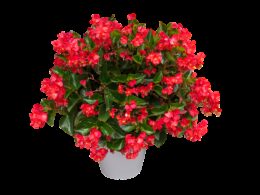As the end of the growing season approaches, it’s time to start thinking about what to do with your begonias. Whether you’ve been growing annuals or perennials, there are a few steps you can take to ensure they survive the winter and come back strong next year.
Don’t let the changing weather catch you off guard – with a little bit of planning and care, your begonias can thrive for years to come.
First, it’s important to determine whether your begonias are annuals or perennials. Annual begonias typically only last for one growing season, while perennials can come back year after year. Depending on which type you have, you may need to take different steps to care for them. But no matter what, there are a few key things you can do to help your begonias make it through the winter and come back even stronger next year.
Determine if Your Begonias are Annuals or Perennials
You’ll want to figure out whether your begonias will come back next year before deciding what to do with them as the weather cools down. Are they annuals or perennials? Understanding begonia lifecycles is important in determining how to care for them.
Annual begonias will only last for one season, while perennial begonias can come back year after year. If your begonias are annuals, you’ll want to enjoy them as much as possible before it gets too cold. Once the weather starts to dip below freezing, they will likely die off. You can also try to extend their lifespan by bringing them indoors or covering them with a protective layer, but this is not always successful.
If your begonias are perennials, you can overwinter them so they come back strong next year. Overwintering begonias involves preparing them for dormancy by cutting back the foliage and storing them in a cool, dry location. Tips and tricks include ensuring they receive proper ventilation and monitoring them for any signs of disease or pests. With the right care, your begonias can come back better than ever next season!
Caring for Annual Begonias
Take care of your annual begonias by providing them with proper care and attention throughout the growing season. Here are three essential tips to ensure your begonias thrive:
-
Water regularly: Begonias love moist soil, so be sure to water them regularly. However, be careful not to overwater them as this can lead to root rot. Check the soil with your finger before watering and only water when the top inch of soil feels dry.
-
Fertilize monthly: Annual begonias need regular feeding to maintain their vibrant blooms. Use a balanced fertilizer once a month to keep them healthy and blooming.
-
Watch out for pests: Common pests that can affect begonias include spider mites, whiteflies, and mealybugs. Check your plants regularly for signs of infestations and treat them promptly to prevent the pests from spreading.
When the growing season ends, it’s time to consider overwintering strategies for your begonias. You can bring them indoors and place them in a sunny spot, or you can dig up the tubers and store them in a cool, dry place until spring. Whichever method you choose, be sure to trim back the foliage and remove any dead or diseased leaves to prevent the spread of disease.
Incorporating these simple tips into your begonia care routine will help ensure that your annual begonias remain healthy and vibrant throughout the growing season. By providing them with proper care and attention, you can enjoy their beautiful blooms for months to come.
What Should I Do With Geraniums at the End of the Season Like I Do with Begonias?
When it comes to end-of-season geranium care tips, it’s crucial to give them the attention they deserve. Just like begonias, geraniums can benefit from some care to ensure their survival during the winter. Consider trimming back the foliage and bringing them indoors before the first frost. Provide adequate light and water during this transition period to help them adjust and thrive until the next growing season.
Caring for Perennial Begonias
When caring for perennial begonias, you should consider pruning and cleaning them regularly. This will help maintain their shape and prevent diseases from spreading.
Additionally, mulching and winterizing your begonias will help protect them from harsh weather conditions and ensure they come back healthy in the spring.
Pruning and Cleaning
It’s important to prune and tidy up your begonias before the colder months set in to keep them healthy and prepared for next season.
Pruning techniques for begonias vary depending on the type of begonia you have and its growth habit. For example, fibrous begonias should be pinched back regularly to encourage bushier growth, while tuberous begonias should be deadheaded to promote more blooms.
When it comes to cleaning tools, it’s best to use a pair of sharp, clean pruning shears to avoid damaging the plant. You may also want to use a soft-bristled brush or cloth to gently remove any debris or dust from the leaves.
This will help prevent the spread of disease and ensure that your begonias are in top shape for next season. By taking the time to prune and clean your begonias before winter, you’ll be setting them up for success and ensuring that they’ll thrive when warmer weather returns.
Mulching and Winterizing
To keep your begonias healthy and protected during the colder months, mulch around the base of the plant and cover with a layer of protective material like burlap or frost cloth. Choosing the right mulching materials is crucial to ensure that your begonias survive the winter. Here are some tips to help you choose the best mulching materials:
- Use organic materials like leaves, straw, or pine needles to provide insulation and retain moisture.
- Avoid using materials that can trap moisture and cause rot, such as plastic or rubber.
- Apply a layer of mulch that’s at least 2-3 inches thick to protect the roots from freezing temperatures.
Make sure to leave a small gap between the mulch and the stem to prevent moisture buildup and fungal growth. Check the mulch periodically throughout the winter to ensure that it hasn’t shifted or become compacted.
Winterizing techniques are also important to protect your begonias from the harsh winter weather. Here are some additional tips to help you winterize your begonias:
- Water your begonias thoroughly before the first frost to ensure that they’re well-hydrated.
- Prune any dead or damaged branches to prevent disease and promote healthy growth in the spring.
Cover the entire plant with a layer of burlap or frost cloth to protect it from wind and frost. Place a layer of mulch around the base of the plant to provide additional insulation. Keep an eye on the weather forecast and be prepared to take additional measures if necessary, such as adding extra layers of protection or moving the plant to a more sheltered location.
Propagating Begonias
Get ready to expand your begonia collection by learning how to easily propagate them. Propagating begonias is an easy and inexpensive way to create new plants from existing ones.
Two common methods of propagation are leaf cutting and root division. For leaf cutting, select a healthy leaf and cut it off at the stem. Then, cut the leaf into sections, making sure each section has a vein. Place the sections in a pot with moist soil and keep them in a warm, humid area. In a few weeks, new plants will begin to grow from the sections.
Root division is another method of propagation. Carefully dig up the begonia and separate the roots into sections. Each section should have at least one stem and several roots. Plant each section in a pot with moist soil and keep it in a warm, humid area. New plants will begin to grow from the roots in a few weeks.
Expanding your begonia collection is easy with propagation. By using leaf cutting or root division, you can create new plants from existing ones. With a little patience and care, you’ll have a beautiful collection of begonias in no time.
Do Begonias and Hostas Require Similar End-of-Season Care?
Yes, both begonias and hostas require similar end-of-season care, including cutting hosta flowers for health. This process helps promote new growth and also prevents the plants from self-seeding. Additionally, cleaning up foliage and protecting them from frost will prepare both begonias and hostas for the coming winter.
Storing Begonias for the Winter
If you want to keep your begonias healthy and thriving during the winter months, it’s important to know how to properly store them. Overwintering techniques vary depending on the type of begonia you have. However, here are three general long-term storage solutions that you can apply to most begonias to keep them healthy during the colder months.
Firstly, you can dig up the entire plant and store it in a container. Make sure to shake off any excess soil and cut back the foliage to about 2 inches.
Next, place the container in a cool, dark room with temperatures around 45-50°F. Check on the plant once a month and water it sparingly to avoid rotting.
Secondly, you can propagate the begonia and keep it indoors during winter. Take cuttings from the plant and root them in soil or water. Once they have rooted, pot them and place them in a sunny window.
Keep the soil moist but not too wet. This way, you can enjoy your begonia throughout the winter and have new plants to care for in the spring.
Lastly, you can store the tubers of the begonia in a cool, dry place. Dig up the tubers and let them dry in a warm, dry location for a few days. Once dry, wrap them in dry peat moss or vermiculite and store them in a cool, dark location with temperatures around 45-50°F.
Check on the tubers once a month and moisten the peat moss if it becomes too dry.
By following these overwintering techniques and long-term storage solutions, you can ensure that your begonias will survive the winter and thrive again in the spring. With a little bit of care and attention, you can enjoy your beautiful begonias year after year.
Frequently Asked Questions
Can begonias survive outdoors in colder climates during the winter?
To protect your Begonia plants during the winter, you should take some measures to ensure their survival. Begin by choosing the right variety of Begonia that’s suitable for colder climates. Some varieties, such as the tuberous Begonia, can withstand frost and freezing temperatures.
You can provide winter protection by mulching around the base of the plant with a layer of straw or leaves. You can also cover the plant with a frost cloth or burlap to provide extra insulation. By taking these steps, your Begonia plants can survive the winter and continue to thrive in the spring.
How can I prevent diseases and pests from affecting my begonias?
To keep your begonias healthy and thriving, it’s important to take preventive measures against diseases and pests. One simple way to do this is through natural remedies.
For example, you can use neem oil or insecticidal soap to ward off common pests like spider mites and mealybugs. Additionally, you can prevent diseases by ensuring proper drainage and avoiding overwatering your begonias.
Regularly inspecting your plants and removing any damaged or diseased leaves can also help keep them healthy. By taking these simple steps, you can help protect your begonias and ensure they stay beautiful and vibrant all season long.
Can I grow begonias indoors during the winter?
You can certainly grow begonias indoors during the winter months. To start, choose a container that’s the right size for your plant and make sure it has proper drainage.
Indoor lighting is important for begonias, so place them near a window that gets plenty of sunlight or use artificial lighting. Watering frequency will depend on the type of begonia you have, but generally, it’s best to let the soil dry out a bit before watering again.
Fertilization is also important to keep your plant healthy, but be careful not to over-fertilize. With proper care, your indoor begonias can thrive and bring color to your home throughout the winter season.
Are there any special considerations for overwintering tuberous begonias?
When it comes to tuberous begonia storage during the winter, there are a few key tips to keep in mind to ensure they survive until the next growing season.
First, allow the foliage to die back naturally before removing it.
Then, gently dig up the tubers, being careful not to damage them, and shake off any excess soil.
Store the tubers in a cool, dry place with good air circulation, such as a basement or garage, for the winter.
Before storing, dust the tubers with a fungicide to prevent any potential fungal infections.
Check on the tubers periodically throughout the winter to ensure they are not drying out or becoming moldy.
By following these winter care tips, you can ensure your tuberous begonias will be ready to thrive again come spring.
How do I know when it’s time to prune my begonias?
To keep your begonias healthy and looking their best, it’s important to know when and how to prune them. Pruning techniques vary depending on the type of begonia you have, but in general, you’ll want to remove any dead or damaged leaves and stems.
You may also want to shape the plant by removing any branches or shoots that are growing out of control. To determine when it’s time to prune, you’ll need to create a maintenance schedule based on the specific needs of your begonia.
By staying on top of pruning and other maintenance tasks, you’ll help ensure that your begonia stays healthy and beautiful year-round.
Conclusion
So, what should you do with your begonias at the end of the season? First, determine if they’re annual or perennial. If they’re annuals, you can simply let them die off and dispose of them. However, if they’re perennials, you’ll need to take steps to ensure they survive the winter and come back strong next year.
For annual begonias, you can simply cut them back and dispose of them. However, if you want to save the tubers for next year, you can dig them up and store them in a cool, dry place.
For perennial begonias, you’ll need to prepare them for winter by cutting back the foliage and covering the roots with a layer of mulch or straw.
Propagating your begonias is also a great way to ensure their survival for next year. You can take cuttings from healthy plants and root them in water or soil.
Finally, if you don’t want to go through the trouble of storing or propagating your begonias, you can always treat them as annuals and simply enjoy them for the season before letting them go.








